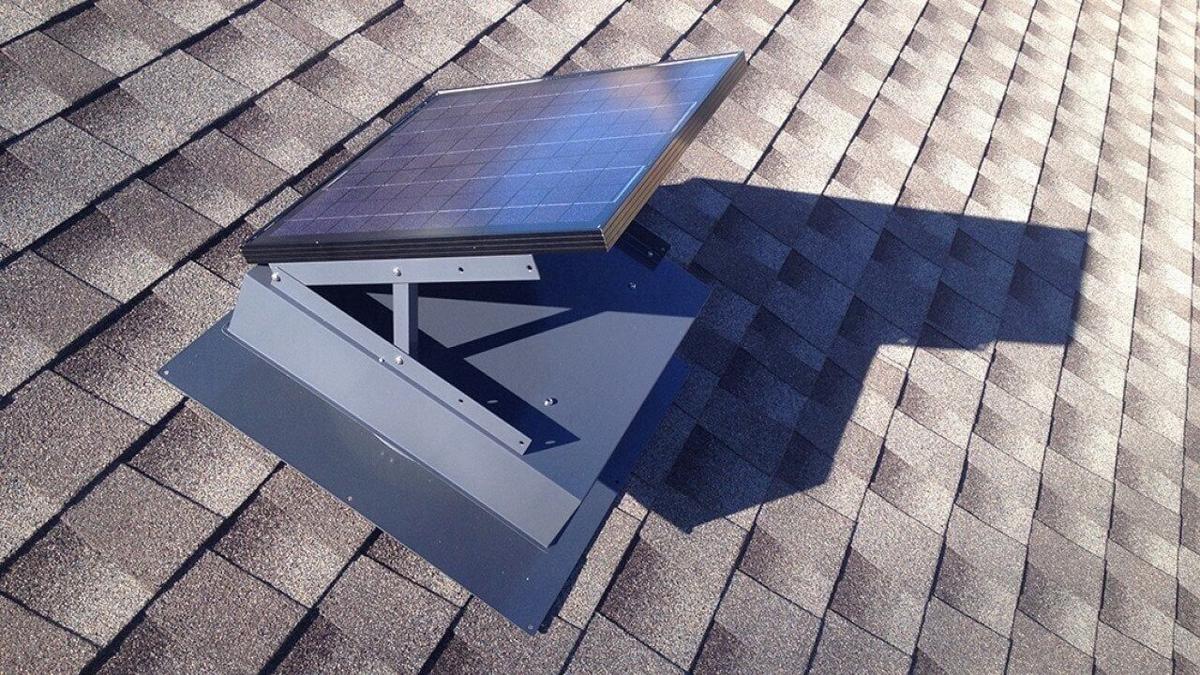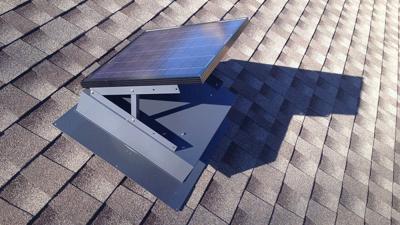![]()
How solar attic fans offer relief from soaring energy costs in 2025
Cooling your home this summer will likely cost more than ever. Across the U.S., residential electricity bills are climbing fast, just as forecasters warn of another season of unrelenting heat.
According to the National Energy Assistance Directors Association, the average American household is expected to between June and September. That’s a record high, up nearly 14% since 2020. For families already stretched thin by inflation, it’s one more financial burden stacked on top of rising grocery bills, housing costs, and healthcare expenses.
People are also reading…
However, rising temperatures alone aren't the only cause for the spike. It’s the grid itself. Electricity prices are climbing faster than inflation, fueled by utility investments to upgrade aging infrastructure and offset supply chain volatility.
What's more, the cost of transmission and distribution are now outpacing power generation, according to , meaning even small increases in usage hit harder at the meter.
Meanwhile, extreme heat waves are becoming more frequent and harder to ignore. Especially across states like Texas, Arizona, Florida, and California, where cooling isn’t a luxury—it’s survival.
As temperatures climb, so does demand for air conditioning, pushing already stressed systems to their limits. And the higher the demand, the more households pay for every extra degree of relief.
For many households, the question is no longer whether this summer will be hot. It’s whether they can afford to stay cool. And with electricity prices projected to keep rising through 2026, the urgency for affordable, energy-smart solutions has never been greater.
This is where climate solar attic fans come in. By utilizing technology that tackles heat buildup at the source, they offer a strategic way to reduce cooling needs and ease the load on overstretched HVAC systems. And in 2025, they could be more than a smart upgrade; they may be a financial lifeline. explains how solar attic fans work and how they may help people decrease their energy costs.
What Are Solar Attic Fans and How Do They Work?
Most homeowners underestimate how much heat and moisture build up in their attic, an often overlooked space. On a scorching summer day, attic temperatures can climb above 130 degrees Fahrenheit. That sweltering air doesn’t stay trapped. It radiates downward through the ceiling, forcing your air conditioner to run harder and your energy bills to climb.
However, a solar attic fan takes aim at that issue directly. This compact device mounts on your roof and draws all its power from a small solar panel on top.
When sunlight hits the panel, it generates electricity to turn the fan’s motor. The fan then extracts hot, humid air from the attic, pushing it through existing vents—whether soffit or gable. As this stale air moves out, cooler air enters, keeping the attic cooler and drier.
This steady airflow does more than just lower attic temperatures. In many homes, an unvented attic behaves like a giant radiator. However, by reducing attic heat by up to 20 degrees Fahrenheit, the solar fan eases the burden on your HVAC system.
Reducing attic heat by this amount can cut air conditioner runtime significantly. that lowering attic temperatures can reduce the overall cooling load by 10% to 30%. And because solar attic fans are self-powered and activate only during daylight hours (when attics and cooling systems are under the most strain), they avoid wasting electricity and sidestep unexpected energy costs.
By shifting the heat battle to your attic, solar attic fans deliver more than just comfort; they bring immediate financial relief. They help your HVAC system work smarter, not harder, while lowering energy usage and reducing monthly bills. And for homeowners in warm climates, they’re not just a solution, they’re a practical tool for resilience in the face of rising temperatures and energy prices.
Why Solar Attic Fans Make Economic Sense in 2025
Beyond lowering attic temperatures, solar attic fans offer broader benefits that impact your home’s overall health, your monthly budget, and your long-term financial outlook.
One of the most overlooked advantages is moisture control. During colder months, warm indoor air rises and condenses on cooler attic surfaces. That trapped moisture creates the perfect environment for mold, mildew, and wood rot.
As mentioned earlier, consistent attic ventilation not only curbs summer heat, it also regulates humidity year-round. Helping to prevent costly structural damage and ice dams during winter.
Another key benefit is energy independence. Because solar attic fans are powered entirely by sunlight, they operate without drawing from the grid. Once installed, they run autonomously, with no increase to your electricity bill.
But the real financial punch comes from return on investment. With price tags between $300 and $600 for many units, homeowners can often install them without an electrician. And thanks to the 30% Residential Clean Energy Credit under the Inflation Reduction Act, homeowners can recover much of their cost through tax savings. Many home upgrades take many years to recoup costs, but solar attic fans deliver real savings more quickly, especially in warmer states like Florida or Texas.
Once that payback period passes, the savings continue. Homeowners often see reduced cooling costs in the hottest months and less wear and tear on HVAC systems. That can mean fewer emergency repair calls and a longer lifespan for expensive equipment.
For additional savings, many states and municipalities offer their own rebates. Tools like let you search for local incentives by zip code.
To claim federal credits, keep your receipts and consult a tax professional to ensure everything is filed properly. With electricity rates expected to rise again in the third quarter, taking advantage of current incentives could save you hundreds, possibly thousands, over time.
The Climate and Equity Connection
Beyond dollars and efficiency, solar attic fans now sit at the intersection of two growing national emergencies: climate change and energy inequality.
Last year was the hottest on record globally, with the National Oceanic and Atmospheric Administration reporting a above the 20th-century average. That marks the 10th consecutive year of record-breaking heat, with each one climbing higher than the last.
What was once considered abnormal is now the new baseline. And in the U.S., especially across the South and Southwest, heat isn’t just inconvenient anymore. It’s deadly.
For millions of Americans, the rising cost of cooling is not just a budgeting issue. It’s a health risk. Mark Wolfe, executive director of the National Energy Assistance Directors Association, summed up the crisis plainly: “Without access to affordable cooling, many will be at risk of heat stroke and other health impacts associated with rising temperatures.”
The statistics are sobering. are currently behind on their utility bills, with energy debt rising sharply over the past year. At the same time, summer temperatures are intensifying. In 2023, compared to 2020, according to a study published in JAMA.
These effects are not spread evenly. In hotter states like Texas, Arizona, and Florida, air conditioning isn’t optional. It’s life support. Yet the households most vulnerable to extreme heat—retirees on fixed incomes, families below the poverty line, individuals with chronic health conditions—are often the least equipped to handle the rising costs.
On average, . That’s nearly three times the percentage spent by higher-income groups.
Making matters worse, many of these homes are older and poorly ventilated. That allows attic heat to accumulate and seep into living spaces, putting extra strain on already aging air conditioning systems. The result is a cycle that’s hard to break: The hotter the attic gets, the harder the AC works, and the higher the bills climb.
This is where solar attic fans can shift the equation. By passively reducing attic temperatures, these fans lower the burden on cooling systems without adding anything to the monthly utility bill. For homes that can’t afford full-scale solar installations or major HVAC upgrades, this small intervention can offer real, measurable relief.
Energy economist Sarah Chavez of the American Council for an Energy‑Efficient Economy puts it plainly: “These fans may not be glamorous but they offer immediate relief for families most affected by energy inflation.”
Unlike many green technologies, solar attic fans don’t require large upfront investments, loans, or complicated installation. With the 30% Residential Clean Energy Credit in place, they remain one of the few energy-saving upgrades accessible to lower- and middle-income households.
That kind of accessibility matters. Especially in regions where the cost of cooling is outpacing wages, and where federal assistance programs are underfunded and overextended. Solar attic fans stand out as one of the few solutions that offer meaningful impact without red tape. No waiting lists, no contractors, no decades-long payback. Just sunlight, airflow, and a need to stay cool.
Why Homeowners Should Act Now
While the results speak for themselves, the real question is whether homeowners will act in time, before the next heat wave tightens its grip.
Summer 2025 is already being projected as another scorcher. NOAA’s long-range seasonal outlook warns of continued above-average temperatures across much of the southern U.S., with prolonged heat waves likely to begin earlier and stretch deeper into the fall. For families already straining under rising energy bills, waiting means more money lost and more discomfort endured.
That urgency is compounded by limited-time incentives. The federal government currently offers a 30% tax credit on qualified solar installations, including solar attic fans, now through 2032. That’s a meaningful offset for anyone weighing the upfront cost of installation against long-term savings. It also lowers the barrier for families who’ve been priced out of other home energy upgrades.
But incentives won’t wait for the heatwave to arrive. And as demand spikes, local availability and contractor bandwidth could narrow. Many solar installers book up fast once the season hits its peak, especially across high-heat markets like Arizona, Texas, and Southern California. The earlier homeowners assess their eligibility, the better positioned they’ll be to take advantage.
For households on fixed incomes, retirees, or those simply trying to stretch every dollar, delaying means absorbing another summer of inflated bills and stifling attic heat. And for those thinking long-term—about property value, sustainability, and climate resilience—a solar attic fan is a low-cost, high-return move that’s well within reach.
Now is the time to check eligibility, talk to a qualified installer in your area, and take a step that will pay off not just in comfort, but in safety and peace of mind. Because while no one can stop the heat, there are still choices that make living with it a lot more affordable and comfortable.
was produced by and reviewed and distributed by .



















